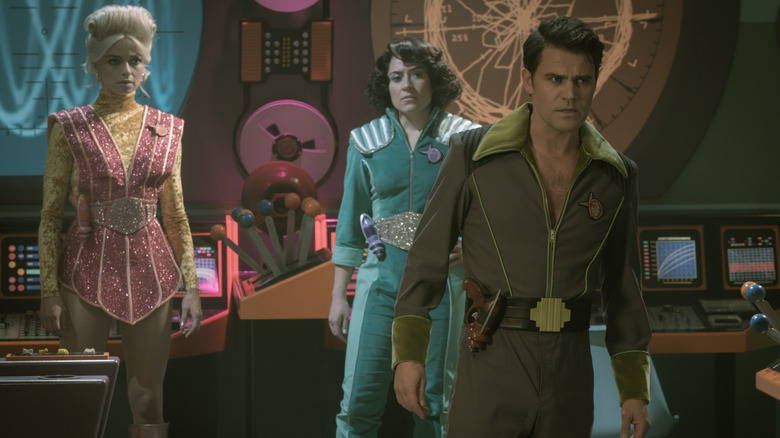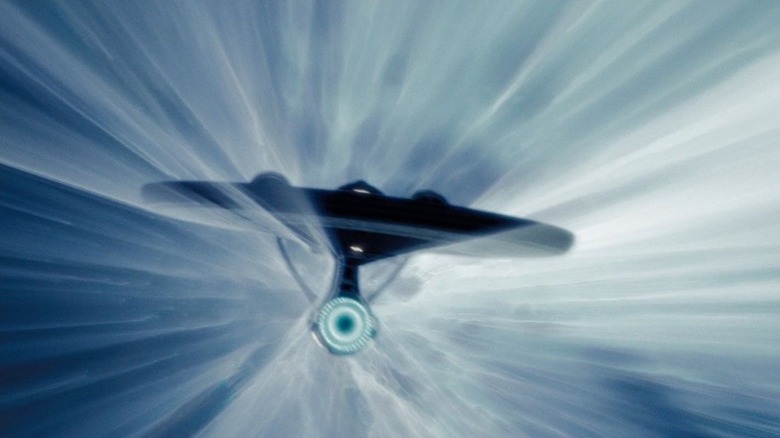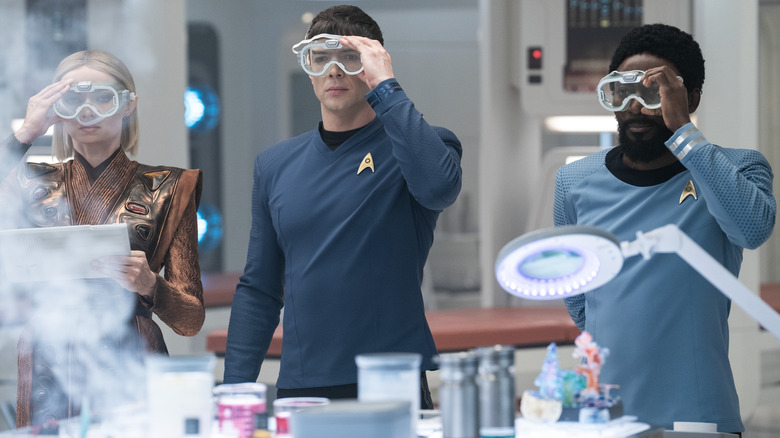One Of Star Trek's Most Remarkable Sci-Fi Concepts Could Become Reality
Throughout its nearly 60 years of movies and shows, "Star Trek" has featured high-tech communication devices that vaguely resemble old-school flip phones, magical replicators that can conjure pretty much any known object at will, and a galaxy full of aliens that happen to look just like humans (although there's a solid canonical reason for that now). But for every goofy-looking visor or turbo lift that requires passengers to grab onto a handle, there are countless more gadgets and theories that have a basis in actual science. Now, one of the most far-fetched ones could be closer than ever to becoming a reality.
Even the most casual of "Trek" fans have heard about the warp drive device that allows the various starships of the Federation to skip through space in the (relative) blink of an eye. There's a reason why faster-than-light travel has remained a fixture in sci-fi for well over a century, after all. Space is very, very big, and humanity has always dreamed of venturing out very, very far. To date, however, this technology hasn't just been considered out of our reach — it's downright impossible, as it would defy all the laws of physics as we know it. The biggest one of them all? Thou shalt not travel faster than light, the universally-accepted speed limit of the universe.
As it turns out, maybe it's time we went back to the drawing board. According to a recent article by National Geographic, there may be a way to turn this particular piece of fiction into fact ... and "Star Trek" could end up being a major reason why. Astrophysicist and warp drive researcher Alexey Bobrick is quoted as saying, "It's amazing how science fiction writers imagine things, and we then figure out they can work. It's really quite beautiful."
How does Star Trek's warp drive work, anyway?
Believe it or not, it appears that Gene Roddenberry (famously a stickler for rules) and his "Star Trek: The Original Series" writers were ahead of their time. Although visually similar to how, say, the Millennium Falcon travels through hyperspace in "Star Wars," the use of the warp drive in "Star Trek" comes much closer to aligning with real-world physics than we ever could've expected.
According to the made-up rules of this franchise, the warp drive essentially works by folding space-time around a moving starship into a bubble, which is then sped up to velocities that far exceed the speed of light. (This is definitely an oversimplified version, as it involves far too much math and decimal points to properly explain here. I'll leave that to the fan wikis, thank you very much.) Compared to other sci-fi properties that rely on wormholes or slipstream methods or what have you, "Trek" manages to avoid the pesky problem that a certain genius named Albert Einstein came up with — namely, the theory of relativity that states no objects in the known universe can physically travel faster than light. While this would seem to include objects such as starships, "Trek" posits that it isn't the USS Enterprise that's being warped to impossible speeds, but actual space-time.
This technicality is the key, apparently. And we've seen this in live action before, as one gloriously nerdy shot in 2016's "Star Trek Beyond" depicted (and pulled from actual physics, as explained to Trek Core here). National Geographic spoke with "Trek" science advisor and astrophysicist Erin MacDonald, who explained:
"If you wrap your ship in the fabric of spacetime and then that fabric goes faster than light, carrying you with it, that's actually not breaking any laws of physics."
Science still has a long way to go to catch up to Star Trek ... but it's getting closer
Okay, just to be clear, we're not quite at the point where we can all sign up for Starfleet Academy and venture out to the stars with wide eyes and clear hearts ... but we're getting a little closer! The National Geographic report goes on to explain how the biggest obstacle isn't the concept of warp drive itself, but the immense amounts of energy required to make it work. One research paper published back in 1994 theorized squeezing space-time ahead of a spaceship and expanding space-time behind, the first accepted scientific model showing the warp idea in action. The only drawback? To move even the tiniest of objects, this method required energy approximate to the mass of our sun.
Thankfully, science has advanced by leaps and bounds since 1994. Alexey Bobrick, the astrophysicist quoted earlier, teamed up with Gianni Martire to find a warp bubble solution far more feasible than earlier ones. While theirs currently requires much less energy (somewhere on the level of a few objects the size of Jupiter), it still hasn't cracked the ability to travel faster than light. But even this small amount of progress represents the biggest step yet towards a functional warp drive. It's now a matter of simply making it so ... or, in non-Picard terms, figuring out how to increase the speed while decreasing the amount of energy required.
The report cautions that we remain "several lifetimes" away from ever implementing any of this on a working spaceship – slightly less optimistic than the 2063 date of "First Contact" with the Vulcans, following a successful test of a warp drive in franchise canon — but we're still taking this as a win.


